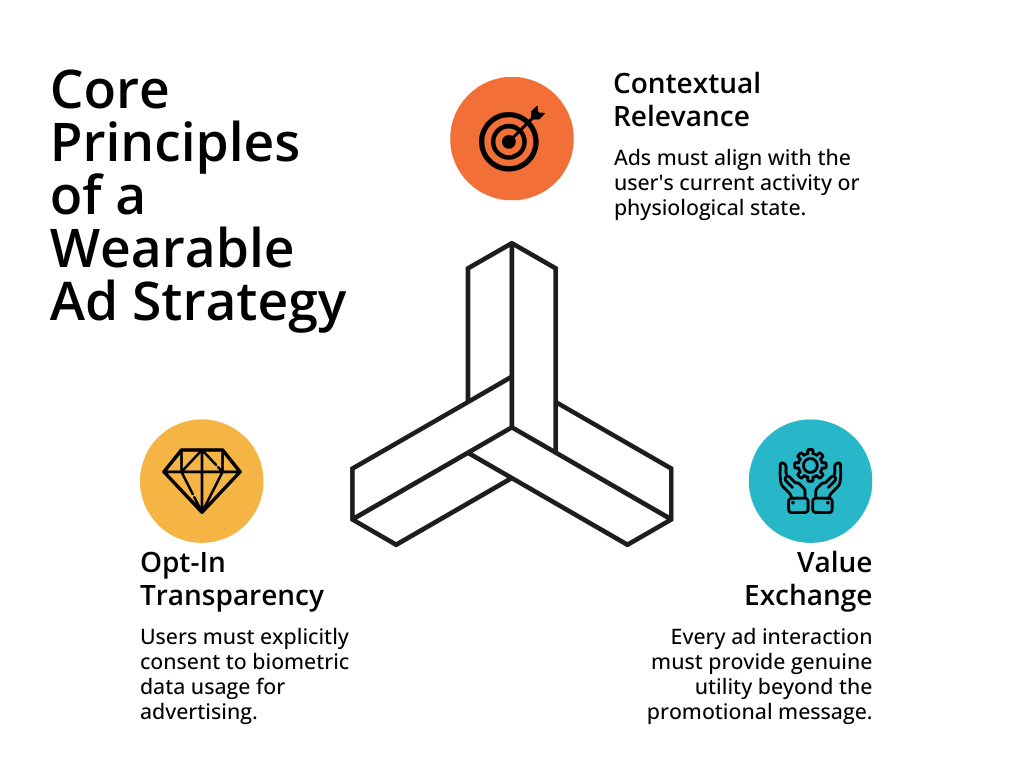How to Use Smart Wearable Ads to Drive Higher Engagement Rates in 2025
Approximately 80 million Americans are currently using health-related smart wearables, with a projected reach of 90 million by 2028. Advertisers can utilize smart wearable ads to boost engagement rates, rather than relying on traditional display advertising. Smart wearable ads transform how brands connect with their audiences. As a result, the wearables market has never been larger or more receptive to contextual, utility-driven advertising experiences.
Biometric-responsive advertising triggers interest and action at the precise moment consumers need your solution. For example, when a smartwatch detects elevated stress levels during a commute, it can surface meditation app promotions. And when AR glasses recognize a user browsing athletic wear, they can overlay virtual try-on experiences. This convergence of sensor data and contextual intelligence creates what industry analysts call “moment marketing”, advertising that feels less like an interruption and more like assistance.
Key Takeaways
- Smart wearable ads are more engaging than traditional display advertising, since they leverage real-time biometric data and contextual intelligence to trigger “moment marketing” that feels like assistance rather than interruption.
- The addressable market is rapidly expanding, with 80 million Americans currently using health-related wearables, projected to reach 90 million by 2028, representing consumers who demonstrate higher engagement rates with premium brands.
- Privacy-first design drives higher conversion rates with campaigns that prioritize transparent data practices, achieving higher opt-in rates, translating directly into stronger customer lifetime value.
- AR glasses show the highest performance potential with immersive overlay ads delivering 44% interaction lift and 19-second average dwell times, despite currently representing only 6% of the wearable market share.
- Success requires the “Utility-First Framework,” focusing on contextual relevance, opt-in transparency, and genuine value exchange rather than traditional brand messaging to overcome technical challenges like battery life constraints and notification fatigue.
TABLE OF CONTENTS:
Market Opportunity: From Niche to Mainstream Revenue Channel
The smart wearable ads market represents one of the fastest-growing segments in digital advertising. Unlike traditional advertising channels, wearable advertising leverages real-time biometric and behavioral data to deliver precisely timed, contextually relevant messages.
| Device Category | Market Share | Primary Ad Format | Engagement Rate |
|---|---|---|---|
| Smartwatches | 62% | Contextual notifications | 19-second average |
| Fitness Trackers | 32% | Achievement-based rewards | 13-second average |
| AR Glasses | 6% | Immersive overlays | 44% interaction lift |
What makes this opportunity particularly compelling for enterprise marketers is the audience, specifically, the precise targeting of motivated, affluent consumers who have already invested in technology to optimize their lives. That’s why wearable device owners exhibit purchase behaviors that skew toward premium products and services.
Performance Benchmarks: Why Smart Wearable Ads Outperform Traditional Channels
The data supporting the effectiveness of smart wearable advertising is compelling. Early AR advertising for AI-driven AR glasses delivers a 30–40% increase in engagement rates compared to static ads. At the same time, biometric-triggered promotions achieve conversion rates that traditional display advertising can’t match.
“The convergence of biometric data and contextual advertising creates unprecedented personalization opportunities. When we can detect that a user’s heart rate indicates they’re exercising, we can serve relevant hydration or recovery product ads with surgical precision.” – BrandXR Industry Report Team
Consider Apple’s seasonal-timing optimization strategy, which demonstrates the power of predictive wearable advertising. Despite facing a 19.8% year-over-year decline in Apple Watch shipments, the company strategically timed campaigns around September–October seasonal spikes in consumer search intent. Search interest in smartwatches peaked at 79 (Google Trends index) during the campaign window, sustaining strong active-use rates among core segments even as overall shipments declined.
Traditional mobile advertising interrupts user workflows, while smart wearable ads enhance them. When Marcolin launched AR try-on campaigns for Guess eyewear, they achieved a 19-second average dwell time and 44% lift in virtual try-on engagement—metrics that would be impossible with traditional banner advertising.
Implementation Strategies: Building Privacy-First Wearable Ad Campaigns
Successful smart wearable advertising requires a fundamentally different approach than traditional digital campaigns. The most effective implementations follow what we call the “Utility-First Framework”—a methodology that prioritizes user value over brand messaging.

The framework consists of three core principles:
- Contextual relevance: Ads must align with the user’s current activity or physiological state.
- Opt-in transparency: Users must explicitly consent to biometric data usage for advertising.
- Value exchange: Every ad interaction must provide genuine utility beyond the promotional message.
Meta’s approach with Ray-Ban Meta Smart Glasses exemplifies this philosophy. Their “Hands-Free Living” campaign showcased AI-powered voice commands, live translation, and real-time sharing through lifestyle-centric storytelling. Rather than interrupting users with traditional ads, the campaign positioned the glasses as problem-solving tools that happened to include sponsored content.
Privacy concerns represent the biggest challenge. 54% of users express concerns about the privacy implications of using their biometric data, including for advertising purposes. Successful campaigns must build trust through transparent data practices and consent.
Overcoming Technical Challenges: Accuracy, Battery Life, and User Experience
While the opportunities are significant, smart wearable advertising faces several technical limitations that marketers must overcome. Sensor accuracy remains inconsistent; for example, wrist-based heart rate monitors tend to be less accurate during high-intensity exercise. This can trigger irrelevant ads, such as energy drink promotions during rest periods, undermining campaign effectiveness.
Battery life constraints create additional complications. Most full-featured smartwatches offer a battery life that lasts an average of one to three days, which limits ad exposure and forces marketers to carefully prioritize message timing. The most successful campaigns work around these limitations by focusing on high-impact moments rather than persistent messaging.
Notification fatigue represents perhaps the most significant challenge to user experience. Brilliant Labs’ Frame glasses addressed this through adaptive delivery algorithms that prioritize urgent messages over promotional content during work hours. This approach reduced user opt-outs by 22% while maintaining engagement rates for priority advertisements.
Future Innovations: AI Integration and Predictive Advertising
The next evolution of smart wearable advertising centers on artificial intelligence and predictive analytics. Neural recommendation engines are beginning to analyze historical biometric patterns to forecast user needs. Predicting migraines via sleep data and proactively suggesting sponsored relief products before symptoms manifest.
Generative AI enables the creation of dynamic content in real-time. ChatGPT-powered smart glasses can compose contextual ad copy as users encounter specific environments, such as generating restaurant descriptions as they gaze at storefronts or creating personalized workout recommendations based on current fitness levels.
Material science innovations will expand advertising surfaces beyond traditional screens. E-textiles are projected to reach $275 billion by 2034, with smart fabrics enabling entirely new ad formats. Adidas’ experimental miCoach soccer jerseys embed pressure sensors that trigger sportswear promotions post-game, creating seamless integration between product performance and purchase opportunities.
Your ROI-Driven Implementation Roadmap
Fitness wearables can do more than track your steps — they can deliver engaging ads to users. Smart wearable ads utilize biometric data to trigger “moment marketing,” leading to higher conversion rates.
There are several key differences between a wearable ad campaign and a traditional one. For example, health and wellness brands should prioritize fitness tracker integrations, while fashion and lifestyle brands can explore AR try-on experiences.
The key metrics to track also differ from traditional digital advertising. Instead of focusing solely on click-through rates, measure engagement duration, biometric response correlation, and cross-channel attribution. Brands should also anticipate the issues that may come with a wearable advertising strategy, such as incorrect data and marketing overload.
Ready to transform your marketing strategy with data-driven wearable advertising? Partner with the leading paid advertising agency that specializes in emerging technologies and delivers growth-driven results. Our team has helped enterprise brands navigate complex digital transformations and achieve measurable ROI from innovative advertising channels.
Want to crack the code on wearable advertising before your competitors catch on?
Frequently Asked Questions
-
What makes smart wearable ads more effective than traditional display advertising?
Smart wearable ads leverage real-time biometric data and contextual intelligence to deliver precisely timed, relevant messages. This approach generates higher engagement rates because ads are triggered at the exact moment consumers need your solution, such as meditation app promotions when stress levels are detected.
-
How do privacy concerns affect wearable advertising campaigns?
Fifty-four percent of users express concerns about the privacy implications of collecting and storing biometric data for advertising purposes. However, campaigns that prioritize transparent data practices and seek consent achieve better opt-in rates, which directly translate into higher conversion rates and stronger customer lifetime value.
-
What is the "Utility-First Framework" for wearable advertising?
The Utility-First Framework consists of three core principles: contextual relevance (ads must align with users’ current activity or physiological state), opt-in transparency (explicit consent for biometric data usage), and value exchange (every ad interaction must provide genuine utility beyond promotional messaging). This methodology prioritizes user value over brand messaging to create more effective campaigns.
-
Which wearable devices offer the best advertising performance?
AR glasses demonstrate the highest performance potential, with immersive overlay ads delivering a 44% interaction lift and an average dwell time of 19 seconds, despite representing only 6% of the wearable market. Smartwatches dominate the market with a 62% share, while fitness trackers account for 32% with achievement-based reward formats.
-
What technical challenges do marketers face with wearable advertising?
Key challenges include sensor inconsistencies, battery life constraints (1-3 days average for full-featured smartwatches), data privacy, and notification fatigue among users. These limitations require strategic timing and prioritization of high-impact moments rather than persistent messaging approaches.
-
How will AI integration change wearable advertising in the future?
AI will enable predictive advertising by analyzing historical biometric patterns to forecast user needs, such as predicting migraines via sleep data and proactively suggesting relief products. Generative AI will also create dynamic, contextual ad copy in real-time as users encounter specific environments, making advertising more personalized and relevant.
-
What metrics should marketers track for wearable advertising campaigns?
Instead of focusing solely on click-through rates, measure engagement duration, biometric response correlation, and cross-channel attribution to achieve brand recall. The most successful campaigns track how closely advertising aligns with user intent, making it feel like a natural extension of the wearable experience rather than an interruption.




